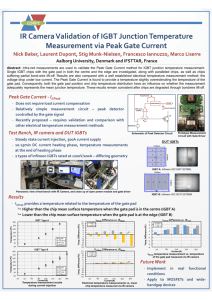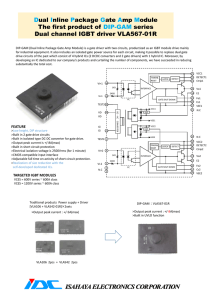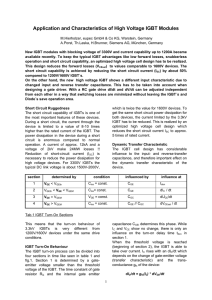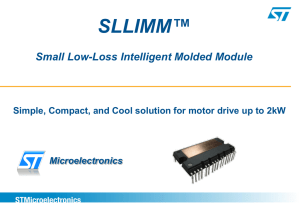Turn-on Loss vs. Free-Wheel Diode Recovery DV/DT in
advertisement
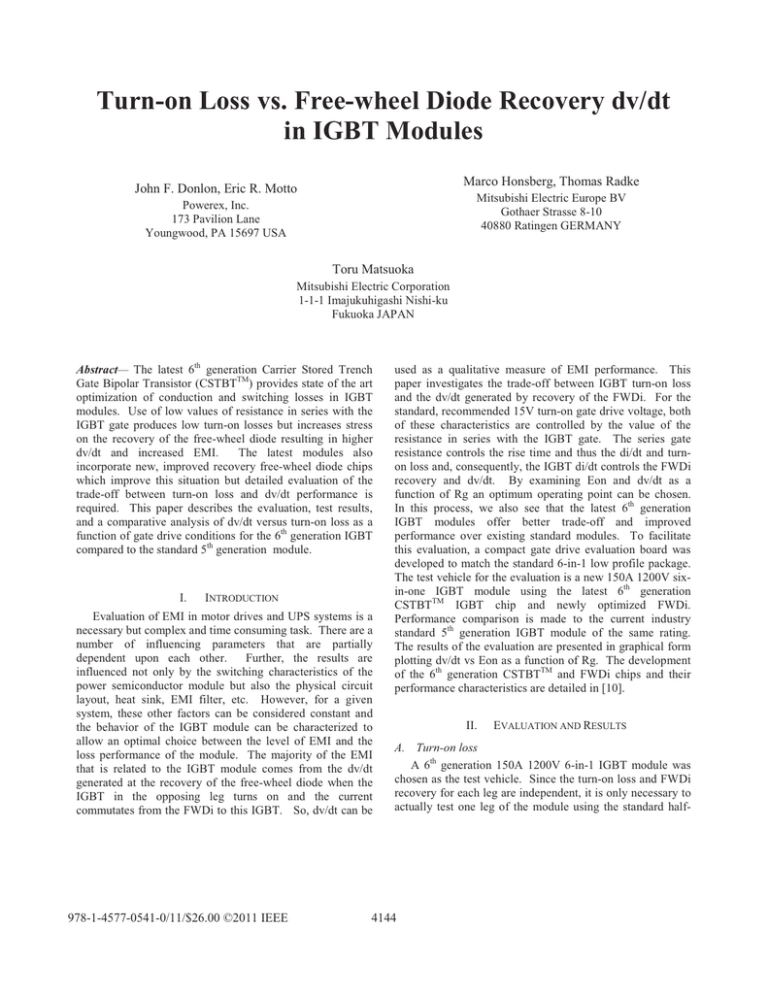
Turn-on Loss vs. Free-wheel Diode Recovery dv/dt in IGBT Modules Marco Honsberg, Thomas Radke John F. Donlon, Eric R. Motto Mitsubishi Electric Europe BV Gothaer Strasse 8-10 40880 Ratingen GERMANY Powerex, Inc. 173 Pavilion Lane Youngwood, PA 15697 USA Toru Matsuoka Mitsubishi Electric Corporation 1-1-1 Imajukuhigashi Nishi-ku Fukuoka JAPAN Abstract— The latest 6th generation Carrier Stored Trench Gate Bipolar Transistor (CSTBTTM) provides state of the art optimization of conduction and switching losses in IGBT modules. Use of low values of resistance in series with the IGBT gate produces low turn-on losses but increases stress on the recovery of the free-wheel diode resulting in higher dv/dt and increased EMI. The latest modules also incorporate new, improved recovery free-wheel diode chips which improve this situation but detailed evaluation of the trade-off between turn-on loss and dv/dt performance is required. This paper describes the evaluation, test results, and a comparative analysis of dv/dt versus turn-on loss as a function of gate drive conditions for the 6th generation IGBT compared to the standard 5th generation module. I. INTRODUCTION Evaluation of EMI in motor drives and UPS systems is a necessary but complex and time consuming task. There are a number of influencing parameters that are partially dependent upon each other. Further, the results are influenced not only by the switching characteristics of the power semiconductor module but also the physical circuit layout, heat sink, EMI filter, etc. However, for a given system, these other factors can be considered constant and the behavior of the IGBT module can be characterized to allow an optimal choice between the level of EMI and the loss performance of the module. The majority of the EMI that is related to the IGBT module comes from the dv/dt generated at the recovery of the free-wheel diode when the IGBT in the opposing leg turns on and the current commutates from the FWDi to this IGBT. So, dv/dt can be 978-1-4577-0541-0/11/$26.00 ©2011 IEEE used as a qualitative measure of EMI performance. This paper investigates the trade-off between IGBT turn-on loss and the dv/dt generated by recovery of the FWDi. For the standard, recommended 15V turn-on gate drive voltage, both of these characteristics are controlled by the value of the resistance in series with the IGBT gate. The series gate resistance controls the rise time and thus the di/dt and turnon loss and, consequently, the IGBT di/dt controls the FWDi recovery and dv/dt. By examining Eon and dv/dt as a function of Rg an optimum operating point can be chosen. In this process, we also see that the latest 6th generation IGBT modules offer better trade-off and improved performance over existing standard modules. To facilitate this evaluation, a compact gate drive evaluation board was developed to match the standard 6-in-1 low profile package. The test vehicle for the evaluation is a new 150A 1200V sixin-one IGBT module using the latest 6th generation CSTBTTM IGBT chip and newly optimized FWDi. Performance comparison is made to the current industry standard 5th generation IGBT module of the same rating. The results of the evaluation are presented in graphical form plotting dv/dt vs Eon as a function of Rg. The development of the 6th generation CSTBTTM and FWDi chips and their performance characteristics are detailed in [10]. II. EVALUATION AND RESULTS A. Turn-on loss A 6th generation 150A 1200V 6-in-1 IGBT module was chosen as the test vehicle. Since the turn-on loss and FWDi recovery for each leg are independent, it is only necessary to actually test one leg of the module using the standard half- 4144 bridge test setup shown in Fig. 1. The configuration is a half bridge in which the upper P-side is continuously biased off. The load is an inductor. The lower N-side IGBT is turned on and off to establish the desired current and conditions for measurement. The basic test conditions are given in Table 1. The total series gate resistance (internal + external) was varied from 10 to 88 ohms. The switching loss, Eon, is the integration of the product of the instantaneous voltage and current during the turn-on interval. The industry standard loss definition is used, integrating from 10% of the current rise to 90% of the voltage fall (i.e., 0.1 x Vcc) as shown in Fig. 2. desaturation detection circuitry and an isolated DC-DC converter. Since the gate resistors can be selected over the entire recommended range, the DC-DC converter and hybrid IC driver output stage have been designed to cover this Rg range even for the highest current rated 6-in-1 IGBT module in this package size for switching frequencies upwards of 20kHz. Safe insulation between control inputs and the IGBT output are realized by a suitable optocoupler and reinforced insulation of the DC-DC converter. t @Vce ( t ) = 10%Vcc Eon = ³i (t ) ⋅vCE (t ) ⋅ dt C t @ Ic ( t ) = 10% Ic Fig. 1. Half-bridge test set-up Ic [A] 150 Vcc [V] 600 Tj [°C] 125 Vge [V] +15 ; -10 Fig. 2 Integration range of turn-on switching loss (Eon) Table 1. Eon test conditions B. dv/dt Measurement FWDi recovery dv/dt and EMI tend to be highest and most problematic at low currents and low temperature. To ensure that the comparison points were valid, the dv/dt test conditions for the 150A module were set as given in Table 2. The test circuit shown in Fig. 1 was modified as shown in Fig. 3 to put the DUT to ground and avoid any measurement issues due to a floating reference point. For these measurements the lower N-side IGBT is continuously biased off and the gate pulses are applied to the upper P-side IGBT. C. Evaluation Board Both Eon and dv/dt tests were performed using a dedicated evaluation board (EVB) as shown in Photo 1. The EVB employs hybrid IC gate drivers with integrated Ic [A] 15 Vcc [V] 600 Tj [°C] 25 Vge [V] +15 ; -10 Table 2. dv/dt test conditions D. Results Initially dv/dt and turn-on energy data were taken at total gate resistances of 13, 35, and 56. Fig. 4 shows the voltage from collector to emitter (i.e., across the FWDi under test) for these three gate resistors. The figure demonstrates the control that Rg exerts over dv/dt. Of course, lower dv/dt results in higher turn-on loss and vice versa. The effect of Rg on turn-on switching loss is shown in Figs 5 and 6. Fig 5 is with Rg=13 while Fig. 6 is with Rg=56 . While the higher Rg of 56 gives a very slow turn-on and almost no 4145 recovery peak in the FWDi, the IGBT turn-on loss is increased considerably. better performing drives or potential cost improvement due to a reduction in EMI filter requirements. Vce Eon Ie Fig. 5 Turn-on waveforms at RG(on)=13 V/div = 100V/div, t/div = 200ns/dv, E/div = 5mj/div Fig. 3 dv/dt test set-up Vce RG(total) = 35Ω RG(total) = 13Ω Eon RG(total) = 56Ω Ie Fig. 4 dv/dt at RG(total) = 13, 35, and 56 V/div = 100V/div, t/div = 50ns/div Fig. 6 Turn-on waveforms at RG(on)=56 Additional tests were conducted at intermediate values of gate resistance and the test results obtained above were combined the these into Fig. 7 with the total gate resistance as a plotting parameter. This graph shows the results for the new 6th generation module along with data for a standard industrial module using 5th generation technology for reference comparison. Since dv/dt has an important impact on aging of motor windings in addition to reflecting the EMI level, it is usually kept below 4 to 8kV/us even when dedicated output filters are used. It is clear from the graph that the new 6th generation IGBT modules offer a better trade-off and 20 to 60% lower Eon for a given dv/dt level. Or, conversely, significantly lower dv/dt is generated for a given Eon loss. III. V/div = 100V/div, t/div = 200ns/dv, E/div = 10mj/div 5th gen CONCLUSION Investigation of a six-in-one IGBT module featuring 6th generation CSTBTTM IGBT and new FWDi chips has shown superior switching loss versus dv/dt trade-off compared to previous generations of IGBT modules. This improved performance of 6th generation modules benefits the user with 4146 Fig. 7 dv/dt vs. Eon as function of RG [6] REFERENCES [1] [2] [3] [4] [5] H. Takahashi, et al., “Carrier Stored Trench-gate Bipolar Transistor (CSTBT) – A Novel Power Device for High Voltage Application,” ISPSD’96, pp.349-352 (1996) A. Porst, et al., “Improvement of the Diode Characteristics Using Emitter-Controlled Principles (EMcon-Diode),” ISPSD’97, pp.213216 (1997) K. Satoh, et al., “A Newly Structured High Voltage Diode Highlighting Oscillation Free Function in Recovery Process,” ISPSD’00, pp.249-252 (2000) H. Nakamura, et al., “Wide Cell Pitch 1200V NPT CSTBTs with Short Circuit Ruggedness,” ISPSD’01, pp.299-302 (2001) K. Nakamura, et al., “Advanced Wide Cell Pitch CSTBTs having Light Punch-Through (LPT) Structures,” ISPSD’02, pp.277-280 (2002) S. Iura, et al., “New 1700V IGBT Modules with CSTBT”, PCIM Europe 2004 [7] N. Clark, et al., “New 1700V A-Series IGBT Modules with CSTBT and Improved FWDi,” Power Electronics Technology Conference Record (2006) [8] T. Takahashi, et al., “CSTBTTM(III) as the Next Generation IGBT,” ISPSD’08, pp.72-75 (2008) [9] K. Satoh, et al., “New Chip Design Technology for Next Generation Power Module,” PCIM Europe Conference Record (2008) [10] J. Donlon and K. Satoh, “IGBT Chip Improvements for Industrial Motor Drives,” Electric Motor and Drive Technology Conference (2009) Photo 1. Evaluation board for 6-in-1 IGBT module with gate drivers and power supplies 4147
